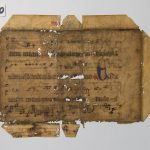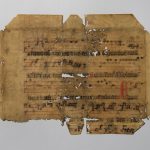The music script of the 15th-century graduale fragment is baffling. The thick gothic pen strokes are more angular and spiky, the neumes more articulated than notation seen in the musical sources of the Hungarian Pauline Order, even though it appears at first glance to be of Pauline origin. Here, too, two pens were certainly used for writing, as at the Paulines, but in a slightly different way: in the case of the climacus, the doubled initial notes were notated with smaller rhombuses, rather than the ones below. This notation fits in well with a particular group of fragments we have discovered. We suspect a distinct Transylvanian school behind them (see also e.g. F 174), which, however, needs to be carefully defined by further research.
In any case, the liturgical material for Monday and Tuesday of the fourth week of Lent is identical with the sources of the Esztergom tradition (this is not surprising, since the common arrangement also reveals a rather fixed order of chants). The melodies, however, are more varied than in a usual Hungarian sub-tradition. So the Esztergom-Pauline origin is weakened by this fact, while the Transylvanian sub-tradition theory is strengthened.
Regarding the provenance, the Fragmenta Codicum volume cataloguing the fragments of the Pauline Library of the Central Seminary (see Bibliography) provides two pieces of information about this manuscript: a late inscription Residentiae Rosnaviensis and an apparently unrelated owner’s name: Bartholomeus Szebeléby (correctly Szebelédy) 1670. The personal name is also on the fragment itself, and offers an interesting path for further thinking, and may even shed light on the question of the origin of the codex fragment. The Rozsnyó entry may suggest a later owner, but we get no further clue here than that.
The identity of Bertalan Szebelédi, however, who owned or used the host book (Matthias Felisius: Catholica praeceptorum decalogi elucidatio published, Antwerp, 1576) can be identified with a high probability. Posterity knows a Franciscan parish priest of the same name from the same time in Transylvania. The will of Fr. Bertalan Szebelédi also survives: he was born in 1631 and died in a Transylvanian village, Kézdiszentlélek in 1707. The date of 1670 in the book confirms our assumption that the owner of the name could be the parish priest of 39 year-old at Kézdiszentlélek. Szebelédi was not just a simple parish priest: he was also elected vicar of Transylvania under the Transylvanian prince Mihály Apafi, who emphasised religious tolerance. With this appointment, Apafy imposed a great task on him, since he obliged him to “repair the defects in the ecclesiastical buildings and to restore the parochial houses and their buildings” (on Szebelédi, see László Makkai, etc., History of Transylvania in three volumes, Volume 2: 1606 to 1830. Budapest: MTA Történettudományi Intézet, 1986, 925, online: http://mek.oszk.hu/02100/02109/html/289.html, moreover Árpád Csáki, “Franciscan parish priests and court chaplains in Háromszék in the 17th–18th centuries”, Acta – 1998. Year Book of the Szekely National Museum and the Csíki Szekler Museum, Vol. 2. Sepsiszentgyörgy: Szekely National Museum, Csíki Szekler Museum, 1999, 85), online: http://epa.oszk.hu/03200/03277/00007/pdf/EPA03277_acta_1998_2.pdf).
The Franciscan relation and the specific Transylvanian connection support our opinion of the above-mentioned Transylvanian school of music writing (it was also proved by the very similar F 174 fragment that was found in the Szamosközy collection, which also has Transylvanian connection), and urge a comparative study of the related codex fragments, not only in the case of the presumably Transylvanian diocesan antiphoner in question.
Gabriella Gilányi



